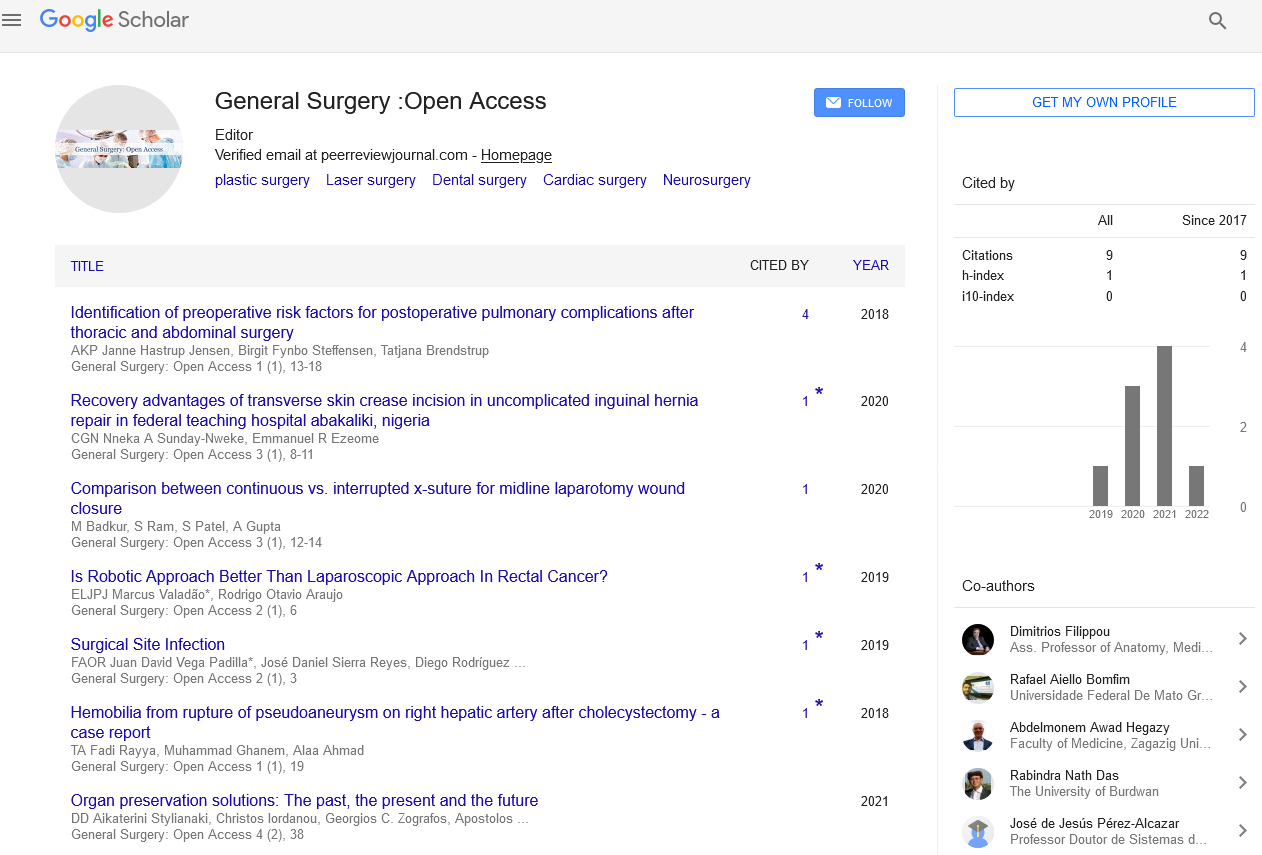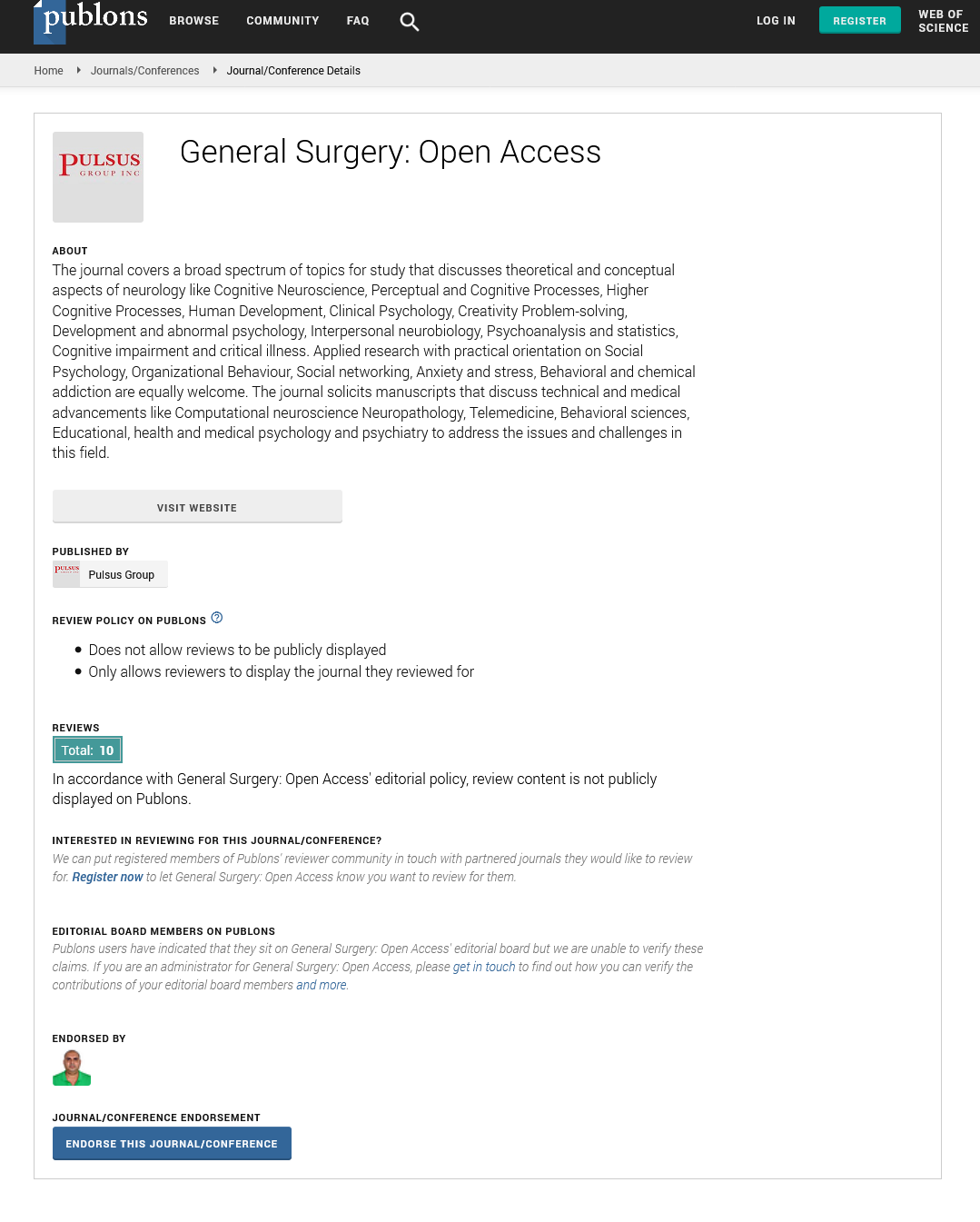In humans and animals, acute intermittent hypoxia promotes hepatic de novo lipogenesis
Received: 22-Mar-2022, Manuscript No. PULGSOA-22-4534; Editor assigned: 24-Mar-2022, Pre QC No. PULGSOA-22-4534(PQ); Accepted Date: Mar 26, 2022; Reviewed: 26-Mar-2022 QC No. PULGSOA-22-4534(Q); Revised: 26-Mar-2022, Manuscript No. PULGSOA-22-4534(R); Published: 28-Mar-2022, DOI: 10.37532/pulgsoa.2022.5(2):8-9
This open-access article is distributed under the terms of the Creative Commons Attribution Non-Commercial License (CC BY-NC) (http://creativecommons.org/licenses/by-nc/4.0/), which permits reuse, distribution and reproduction of the article, provided that the original work is properly cited and the reuse is restricted to noncommercial purposes. For commercial reuse, contact reprints@pulsus.com
Abstract
Non-Alcoholic Unwellness Disease (NAFLD) is that the most typical chronic liver condition. It is tightly related to AN adverse metabolic constitution (including fatness and sort a pair of diabetes) yet like obstructive sleep apnoea (OSA) of that intermittent drive could be a vital part. Internal organ DE novo lipogenesis (DNL) could be a vital contributor to internal organ lipide content and therefore the pathologic process of NAFLD and has been planned as a key pathway to focus on within the development of pharmacotherapies to treat NAFLD. Our aim is to use experimental models to research the impact of drive on internal organ lipide metabolism freelance of fatness and metabolic unwellness. Methods: Human and eutherian studies incorporating stable isotopes and hyperinsulinaemic euglycaemic clamp studies were performed to assess the regulation of DNL and broader metabolic constitution by intermittent drive. Cell-based studies, as well as medical specialty and genetic manipulation of Hypoxia-Inducible Factors (HIF), were wont to examine the underlying mechanisms.
Introduction
Non-alcoholic unwellness} disease (NAFLD) is the commonest worldwide reason behind the disease and is related to multiplied mortality and risk of malignant hepatoma (HCC). Viscus First State Novo lipogenesis (DNL) is the synthesis of recent fatty acids from acyl a coenzyme (acetyl-CoA). DNL is thought to contribute up to 25% of total hepatic lipid content, and DNL levels are higher in individuals with NAFLD. DNL has been linked to HCC in animal models, and DNL's main enzymes, acetyl-Co A carboxylase (ACC) and Fatty Acid Synthase (FASN), are upregulated in human HCC. Although the underlying mechanism(s) between OSA and hepatic steatosis are not fully understood, obstructive sleep apnea (OSA) is an independent risk factor for NAFLD. In animal models, OSA is linked to intermittent hypoxia, which raises hepatic triacylglycerol (TAG) levels. Low oxygen adapts mammalian cells by a well-coordinated transcriptional response mediated by hypoxiainducible factors (HIFs). HIFs regulate a large number of genes that are involved in a variety of physiological functions, including energy metabolism and inflammation. HIFs have a role in a variety of disorders, including cancer and inflammatory ailments, and pharmaceutical techniques to control HIF activity provide intriguing treatment options. The hypoxic control of hepatic lipid metabolism has been established by genetic manipulation of HIFs or Von HippelLindau (VHL) in knockout mice, albeit the relative function of DNL or fatty acid oxidation is unknown. We studied the effect of intermittent hypoxia in an acute model in healthy volunteers in proof-of-concept research utilizing stable isotopes to follow the fates of lipid and glucose within the setting of a hyperinsulinemiceuglycemic clamp, given the potential role of DNL in NAFLD etiology. We tested our findings in a rat model that was exposed to intermittent hypoxia for a long time. Finally, human hepatoma cell lines were employed to see if our findings were dependent on the HIF signaling pathway. Our goal is to examine the influence of hypoxia on hepatic lipid metabolism in the absence of obesity or metabolic illness using these experimental models.
Chronic intermittent hypoxia in rodents
For 14 days, male Wistar rats were given either chronic intermittent hypoxia (CIH) or air. Animals were kept in the open air on the weekends. A total of 16 rats were employed, with eight of them being exposed to CIH and the other eight being subjected to regular ambient air. The animals were housed in groups of four males, with two cages in the hypoxic chamber and two control cages pair-housed directly below it to reduce stress caused by gas fluctuations and/or handling. The animals were obtained through BioMedical Services at the University of Oxford and weighed around 250g when they arrived. The animals were given 6 days to acclimate at the study facility (Department of Human Physiology, Anatomy, and Genetics, University of Oxford). All animals performed fasting blood tests under isoflurane anesthesia from the saphenous vein after 6 days of acclimation and before any CIH exposure. The CIH consisted of 12 exposures per hour to a hypoxic gas mix for 6 hours per day during the animals' sleep time, to mimic the intermittent hypoxia that is a hallmark of obstructive sleep apnea. The animals were housed in modified individually ventilated cages (IVCs) with nitrogen and oxygen intake gases to produce a hypoxic gas mix. 32 seconds of nitrogen (0.5 bar pressure; 14" internal diameter tubing) was enough to lower the FiO2 in the cages to 10% O2 before 4 seconds of oxygen (0.5 bar pressure; 14" internal diameter tubing) restored the FiO2 to 21% (FiO2 of air). Normocap 200 Oxy (Datex Ohmeda/GE Healthcare, UK) gas analyzers were used to monitor the concentrations of O2, CO2, and N2 within the modified IVCs. They were operated through a serial link and coupled to an automated warning and support system. The daily calibration of the Normocap 200 Oxy machines using Quick CalTM Calibration Gas assured accuracy in the measurement of gas handling (GE Healthcare, UK). BOC, based in the United Kingdom, provided all of the gases. A modest axial fan (40 mm x 40 mm x 10 mm) assisted gas mixing via the IVC. Adsorption with CarboLime was used to remove CO2 from the chamber (Allied Health Products, UK). The animals were fed regular chow. For DNA testing, the drinking water was enriched to 3% with deuterated water (CK Isotopes, UK). To ensure that the CIH exposures were tolerable, animals were given 2 hours of CIH on day one, 4 hours on day two, and then 6 hours for the next 14 days. The animals were sacrificed after a minimum of 2 hours of IH exposure on the day of sacrifice and no more than the 6-hour procedure authorized by the license. Fasted animals were slaughtered by extracting the heart from anesthetized animals. Throughout the trial, the animals were weighed every day and checked for signs of suffering. The livers were dissected, and plasma was collected for testing.
Throughout the treatment, drinking water was enhanced with deuterated water to a concentration of 3%. (CK Isotopes, UK). On termination, the rats' livers were removed, weighed, and further dissected. The liver tissue (10 mg) was soaked in 1.5 ml methanol and sonicated for 5 minutes. After that, 3 mL of chloroform was added. The Folch technique was then used to extract the TAG fraction. Each rat's plasma was aliquoted at 100 l. At the start and conclusion of the protocol, samples were obtained. A total of 200 liters of 0.9 percent NaCl was applied. A 3:1 chloroform: methanol solution was added in 3 mL. Because of the little volume of plasma, lipid fractions were not isolated; instead, the entire sample was methylated before drying and dissolving in chloroform.
The quantity of tagged isotope (deuterated water) compared to the unlabeled metabolite in palmitate was then determined using GCMS (Agilent 5973, Agilent, UK). According to the enrichment of the drinking water, a 3 percent enrichment of the plasma water was used to determine the percent DNL. The total TAG in the liver was also measured (Triglyceride Colorimetric Assay kit, Cayman, Ann Arbor, USA). The concentration of total RNA isolated from liver tissue was measured spectrophotometrically at OD260 using a Nanodrop spectrophotometer using Tri-Reagent (Sigma-Aldrich, Dorset, UK) (Thermo Scientific, Hemel Hempstead, UK). For DNA testing, the drinking water was enriched to 3% with deuterated water (CK Isotopes, UK). To ensure that the CIH exposures were tolerable, animals were given 2 hours of CIH on day one, 4 hours on day two, and then 6 hours for the next 14 days. The animals were sacrificed after a minimum of 2 hours of IH exposure on the day of sacrifice and no more than the 6-hour procedure authorized by the license. Fasted animals were slaughtered by extracting the heart from anesthetized animals. Throughout the trial, the animals were weighed every day and checked for signs of suffering. The livers were dissected, and plasma was collected for testing.
Conclusion
The East Midlands Leicester South Research Ethics Committee (15/EM/0308) accepted experimental medicine research in healthy male participants (n=9). Under both normoxia and AIH (12 desaturations/hour to a pulse oximetry saturation (SaO2) of 85–91 percent), volunteers had a hyperinsulinemic-euglycaemic clamp. After a total of 6 hours of exposure to AIH, samples were collected in the fasting condition (after 4 hours of exposure) and after 2 hours of a hyperinsulinemic-euglycemic clamp (after 6 hours of exposure). Both glucose and FFA flow, as well as DNL, were measured using stable isotope tracers (2H2O, 2H-glucose, and 13C-palmitate). Participants tolerated the AIH procedure well, with a mean of 11.3 0.2 desaturations/h to a nadir pulse oximetry O2 saturation of 86.7 0.7 percent.






